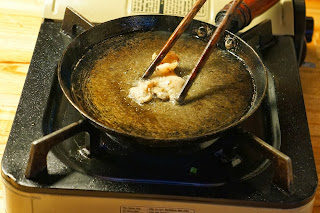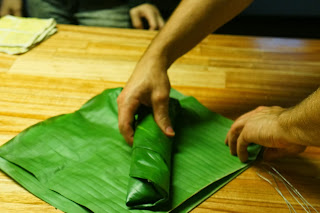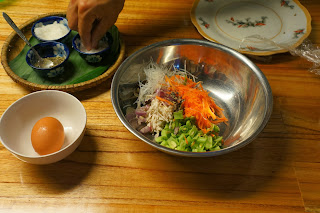Vietnamese food, in particular, consciously appeals to each of the five senses. Obviously there's taste, then there is the way it is arranged on the plate; the colours, textures, shapes are visually appealing. The herbs provide stimulation for our sense of smell. The crunchiness of crisp nems or fresh vegetables is an audible element and a lot of Vietnamese food needs to be picked up, touched, broken apart.
Five is the key number here and the power of five seems far-reaching. Coincidentally, perhaps, the star on Vietnam's flag has five points. In Chinese and derivative cultures, the five-pointed golden star has strong associations with military power and strength.
But I digress.
Five. Intuitively we know, and can taste the careful balance in Vietnamese food, but what we perhaps vaguely sense about the food is a carefully calculated and philosophical approach. Vietnamese dishes are conceived through the balance of five elements; the fundamental taste senses: spicy, sour, bitter, salty and sweet. I wondered how best to describe the sensation of bitter as opposed to sour, for example. But if you think wood for sour and fire for bitter, it makes more sense. And these taste notes correspond to the five organs: gall bladder, small intestine, large intestine, stomach and urinary bladder.
Intriguing, no?
Vietnamese dishes also include five types of nutrients. The plot gets thicker. Powder, water or liquid, mineral elements, protein and fat. And as if that wasn't enough, Vietnamese cooks try to have five colours, which again correspond to the five elements: white/metal, green/wood, yellow/Earth, red (fire) and black (water).
And who amongst you thought it was just a matter of stir-frying some veges in the wok and garnishing with coriander?
Apart from all the eating I did in Vietnam, one of the most impressive experiences of Vietnamese food came through the cooking class with Mr Hung in Hoi An.
The class began with a visit to the market.
Once back at the cooking school, we donned our aprons and chefs' hats, no less, and with a beer in hand, the lesson was underway.
We began with Hoi An pancakes, rice flour batter with chopped spring onion, sizzled pork and prawn and eaten with lettuce and herbs inside rice paper.
Then we prepared the fish grilled in banana leaf and stuffed with a heady filling of garlic, chilli, ginger, red onion and rum.
Vegetarian spring rolls filled with shredded carrot, taro, woodear mushroom, and green bean. Wrapped in rice paper, fried in oil and cut into small cigar rolls.
Green papaya and chicken salad with a salty, spicy, sour dressing.
Happiness is an empty plate and a full belly.


































No comments:
Post a Comment